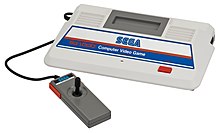
H.E.R.O. (video game)
| H.E.R.O. | |
|---|---|
 Atari 2600 cover art | |
| Developer(s) | Activision |
| Publisher(s) | Activision |
| Designer(s) | John Van Ryzin |
| Platform(s) | Atari 2600, Apple II, Atari 5200, Atari 8-bit, ColecoVision, Commodore 64, MSX, SG-1000, ZX Spectrum |
| Release | March 30, 1984
|
| Genre(s) | Platformer |
H.E.R.O. (standing for Helicopter Emergency Rescue Operation)[1] is a video game designed by John Van Ryzin and published by Activision for the Atari 2600 in March 1984. The game has players control Roderick Hero who traverses a mineshaft avoiding enemies and hazards to rescue trapped miners. He travels through the mines equipped with a hoverpack that allows him to traverse the game levels as well as bombs and laser that let him destroy walls and defeat enemies respectively.

Van Ryzin initially began working at Activision at their New Jersey offices to make a game titled Cosmic Commuter. Initial tests of the game had playtesters comment it was not fun enough, leading Van Ryzin to develop a new game influenced by comic book superheroes that would become H.E.R.O.. Following its release, the game was ported to the Atari 5200, Colecovision, and SG-1000 consoles and the Apple II, Atari 8-bit computers, Commodore 64, MSX, and ZX Spectrum.

The game received positive reviews from publications such as The Video Game Update, Zzap!64 and Retro Gamer. Jeremy Parish said the game was an important game in the development of the platformer game genre as it allowed players to move freely in all directions instead of being forced into climbing ladders or jumping over obstacles which would be seen in later games like Bionic Commando (1988) and Bangai-O (1999).

Gameplay
In Mount Leone, volcanic activity has trapped miners. This leads to Roderick Hero to traverse the mineshafts in order to rescue the workers.[2] The player can set the difficulty through the game select switch with the higher numbers having the players start at later levels in the game. For example, Game number one starts at level one, and game 2 starts at level 5. If the player chooses game level 5, they start at level 17 with all the levels after being random.[2]

The player controls Roderick. Roderick can fly up left or right and hover on the spot. He is equipped with a microlaser beam helmet which allows him to fight most enemies and destroy some walls. Roderick is equipped with six sticks of dynamite per level, which can destroy some walls. Other hazards include lanterns that when touched will go out, causing the screen to go dark.[2]

Players can lose lives by having their power gauge deplete, or interacting with one of the hazards such as spiders, snakes and walls that glow red that contain magma deposits. The power gauge begins depleting as soon as the player begins moving in a level. The player begins the game with four lives with the game ending when the player runs out of them.[2]

Completing a level, shooting enemies, dynamiting a wall and the amount of dynamite and energy left at the end of the level gives the player points. Every twenty-thousand points earns the player an extra life. If the player reaches one million points, the rescue operation ceases.[2]

Development
As Activision grew as a company, it began setting up satellite offices outside of its main California location. The first of these areas was in a New Jersey office which was set-up after Garry Kitchen contacted Activision who was impressed with his work on his port of Donkey Kong that he made for the Atari 2600.[3] Kitchen joined Activision in June 1982.[4] Along with Kitchen, other members joined this New Jersey office for Activision, including H.E.R.O. designer John Van Ryzin. Prior to joining Activision, Van Ryzin had worked on Apple II games with a small group of friends. Van Ryzin began work on a game titled Cosmic Commuter for nine months which he intended to be his first release for Activision. During early playtests of the game, it was decided that it was not ready for release. Van Ryzin was told it was well done technically, but play testers did not find it fun. This led to Van Ryzin developing his next game which would become H.E.R.O.[3]

The inspiration for the game came from Van Ryzin touring a cave on a weekend trip for the games cavern setting. He was also a fan of comic book superheroes as a child, specifically Superman and his destructive heat-vision, all of which would come into play for the general concept of H.E.R.O.[3] With these concepts, Van Ryzin first coded the figure, cave, and controls then began developing the levels, enemies and features of the cave.[3] Van Ryzin created the art, sound effects and programmed the game in assembly language and developed the game via a PDP-11 computer and a debugging tool. Van Ryzin recalled that this was all "state of the art, because before that I wrote games on the Apple II with no debugging tools at all."[5] H.E.R.O. was made for an eight-kilobyte rom cartridge.[6]

Van Ryzin began adding more elements into the game as he developed it, such as a secondary weapon of dynamite and more enemies in the cave such as snakes hiding in the walls.[5] He later recalled that "The most amazing thing about Activision back then was that we had no deadlines or budgets for games - it was done when it was good."[5] Van Ryzin used the time to perfect the controls of the helicopter pack and adjust the difficulty as levels progressed. He designed the middle levels first, then made adjustments from those for the later harder levels and earlier easier levels. He also discussed with other designers in the New Jersey office which he said he received great feedback from.[5] Among the suggestions from his co-workers, were ideas such as the lamps breaking and the lights going out while exploring the cave.[7] Further elements were added into the game as it continued, namely the raft and tentacled monster.[8] Following approval from the staff in California, the staff at that location developed the manual, marketing and packaging for the game.[7]

Release

H.E.R.O. was first released on March 30, 1984.[9] H.E.R.O. was released for ColecoVision in August 1984 while the Commodore 64 and Atari 5200 in the third quarter of 1984.[10] The game was ported the Atari 5200, Colecovision, and SG-1000 consoles and the Apple II, Atari 8-bit computers, Commodore 64, MSX, and ZX Spectrum.[8] The other versions mostly vary with respect to colors and graphic detail, while the SG-1000 version adds music, new traps such as stalactites, lava geysers and featured female miners. Van Ryzen did not code any of these versions, but was asked to approve of them and suggested ideas on the graphics. Van Ryzen suggested for the packaging of the later games to make the character more of a super hero, as on the original game the cover art had him looking "kind of goofy" according to Van Ryzen.[7]

The Atari 2600 version of the game has been re-released on various compilation titles. These include Activision Classics (1998) for the PlayStation and the Activision Anthology for the PlayStation 2, Game Boy Advance, iOS and Android based smart phones.[1][11] H.E.R.O. and various other Atari 2600 Activision games are included as secret game within Call of Duty: Black Ops II (2012).[12]

Reception
| Publication | Score | ||
|---|---|---|---|
| Atari 2600 | C64 | ColecoVision | |
| AllGame | 3.5/5[13] | ||
| Computer and Video Games | 93%[14] | 94%[14] | |
| Personal Computer Games | 8/10[15] | ||
| Zzap!64 | 86%[16] | ||
Reviewing the Atari 2600 game, A reviewer in The Video Game Update noted the game was challenging, writing that most players will accidentally blow themselves up with the dynamite charges before getting used to avoid them. The review went on to praise the games graphics, noting that they were similar to those of Pitfall II: Lost Caverns particularly liking how the recued person waves at the player when rescued.[17] A review in the British magazine TV Gamer gave it straight four out of five scores for value, graphics, sound and gameplay calling it "an excellent game."[18] Lou Hudson of the Fort Worth Star-Telegram opined that the game "isn't a bad action game, but appears to be out of a past generation. A year ago, it would have been excellent. This year, it's a little blah."[19]

In a review of the ColecoVision port, Electronic Games wrote, "Activision has wisely used the superior graphics of the CV units to provide a breathtaking underground panorama," and concluded, "Congrats Activision! H.E.R.O. is a real champion."[20] Reviewing the game for the Commodore 64, Bob Wade of Personal Computer Games noted it was far more action-oriented than any of the mining-themed games as of late, while his fellow critics Chris Anderson and Peter Connor stated the game did not have state-of-the-art graphics for the home computer, it was still very enjoyable and challenging.[15] In the June 1987 issue of Zzap!64, Julian Rignall wrote—of the C64 version—"HERO looks awful, sounds terrible but plays absolutely beautifully."[16] The Japanese magazine Technopolis reviewed the game for the MSX, declaring it to be a really fun game that fit the system perfectly. The review specifically praised the narrative, play control only finding the characters not strong.[21]

From a retrospective review in Computer and Video Games, H.E.R.O. was praised for its colorful graphics while concluding that the addictive gameplay made it one of the best games for the Atari 2600.[14] Brett Weiss included the game in his book on the top 100 console games released between 1977 and 1987. Weiss wrote that the game made you "feel like a real adventure hero [...] a rare feat in the pre-NES era of gaming."[22] In their list of the top 25 Atari 2600 games, Stuart Hunt and Darran Jones of Retro Gamer listed H.E.R.O. as the second best Atari 2600 game. The writers declared that the game mix of action and exploration made it "a truly outstanding release" that was "beautifully designed, with bold detailed visuals and sound effects."[23]

Legacy

Van Ryzen commented that the game was not a great success for him, saying that "Unfortunately the game market crashed at the time, so I did not get the financial rewards I might have gotten. But hey, how many people can say 'I designed a top ten videogame!' That is priceless."[7] Unofficial fan-made versions of the game were produced decades after the lifetime of the game, such as a version in 2005 for the Amstrad CPC.[24] Decades after the games initial release, Van Ryzin created a spiritual successor to the game for the Atari 2600 titled Alien Abduction!. The game was released digitally for the Atari VCS console in 2023.[25][26] It received a physical cartridge release for the Atari 2600 on June 15th, 2024.[26]

Writing for USgamer, Jeremy Parish said the game was important in the development of the platformer game genre. He said that H.E.R.O. allowed players to move freely in all directions instead of being forced into climbing ladders or jumping over obstacles seen in games like Donkey Kong (1981) or Pitfall! (1982).[27] Parish wrote that this form of gameplay would be seen in later games such as Bionic Commando (1988) and Bangai-O (1999) which owed "a debt of gratitude to Activision's classic (if largely forgotten) platformer-that-wasn't."[27]

See also
References
- ^ a b Weiss 2014, p. 109.
- ^ a b c d e Activision 1984.
- ^ a b c d Milne 2015, p. 29.
- ^ Hickey, Jr. 2020, p. 25.
- ^ a b c d Milne 2015, p. 30.
- ^ Fraga 2013, p. 60.
- ^ a b c d Milne 2015, p. 31.
- ^ a b Milne 2015, pp. 30–31.
- ^ United States Copyright Office.
- ^ Computer Entertainer includes The Video Game Update 1984a, p. 92.
- ^ Harris 2003.
- ^ Fraga 2013, p. 63.
- ^ Weiss.
- ^ a b c Computer and Video Games 1989.
- ^ a b Wade 1984.
- ^ a b Rignall 1987, p. 26.
- ^ The Video Game Update includes Computer Entertainer 1984, p. 162.
- ^ TV Gamer 1984.
- ^ Hudson 1984, p. 14E.
- ^ Salamone 1985, pp. 74–75.
- ^ テクノポリス 1984, p. 78.
- ^ Weiss 2014, pp. 108–109.
- ^ Jones & Hunt 2008, p. 32.
- ^ Fraga 2013, p. 61.
- ^ Audacity Games.
- ^ a b Yarwood 2024.
- ^ a b Parish 2014.
Sources
- "ヒーロー" [Hero]. テクノポリス [Technopolis] (in Japanese). December 12, 1984.
- R. Hero's Guide to Rescue Etiquette. Activision. 1984. AZ-038-03.
- "Alien Abduction!™ Features". Audacity Games. Archived from the original on July 16, 2024. Retrieved July 16, 2024.
- "Complete Games Guide" (PDF). Computer and Video Games. No. Complete Guide to Consoles. United Kingdom. October 16, 1989. p. 58. Retrieved January 9, 2024.
- "Availability Update". Computer Entertainer includes The Video Game Update. Vol. 3, no. 6. September 1984.
- "The New Games". TV Gamer. April 1984. pp. 49–50.
- "H.E.R.O." United States Copyright Office. Archived from the original on June 13, 2024. Retrieved June 13, 2024.
- "Critically Speaking.. Atari 2600-Compatible". The Video Game Update includes Computer Entertainer. Vol. 2, no. 11. February 1984.
- Fraga, Eric (February 2013). "H.E.R.O.". Old!Gamer (in Portuguese). No. 13.
- Harris, Craig (December 11, 2003). "Activision Anthology". Retrieved January 8, 2024.
- Hickey, Jr., Patrick (2020). The Mind Behind Adventure Games: Interviews with Cult and Classic Video Game Developers. McFarland & Company, Inc. ISBN 978-1-4766-7966-2.
- Hudson, Lou (February 25, 1984). "Videoplay". Fort Worth Star-Telegram.
- Jones, Darran; Hunt, Stuart (2008). "Top 25 Atari 2600 Games". Retro Gamer. No. 46. Imagine Publishing. p. 32. ISSN 1742-3155.
- Milne, Rory (2015). "H.E.R.O.". Retro Gamer. No. 146. Imagine Publishing.
- Parish, Jeremy (July 25, 2014). "Five Critical Moments in Platform Game History". USgamer. Archived from the original on July 27, 2014. Retrieved October 30, 2023.
- Rignall, Julian (June 1987). "ZZap! Test". Zzap!64. No. 26. Newsfield Publication.
- Salamone, Ted (January 1985). "H.E.R.O." Electronic Games. Vol. 3, no. 1. pp. 74–75. Retrieved January 8, 2024 – via Archive.org.
- Wade, Bob (October 1984). "Hoverpack Hero". Personal Computer Games. pp. 38–39.
- Weiss, Brett Alan. "H.E.R.O." Allgame. Archived from the original on November 14, 2014. Retrieved January 8, 2024.
- Weiss, Brett (2014). The 100 Greatest Console Video Games 1977-1987. Schiffer Publishing. ISBN 978-0-7643-4618-7.
- Yarwood, Jack (June 7, 2024). "Alien Abduction! is a New Atari 2600 Cart From Activision Legends". Time Extension. Archived from the original on June 7, 2024. Retrieved July 16, 2024.
External links
See what we do next...
OR
By submitting your email or phone number, you're giving mschf permission to send you email and/or recurring marketing texts. Data rates may apply. Text stop to cancel, help for help.
Success: You're subscribed now !
